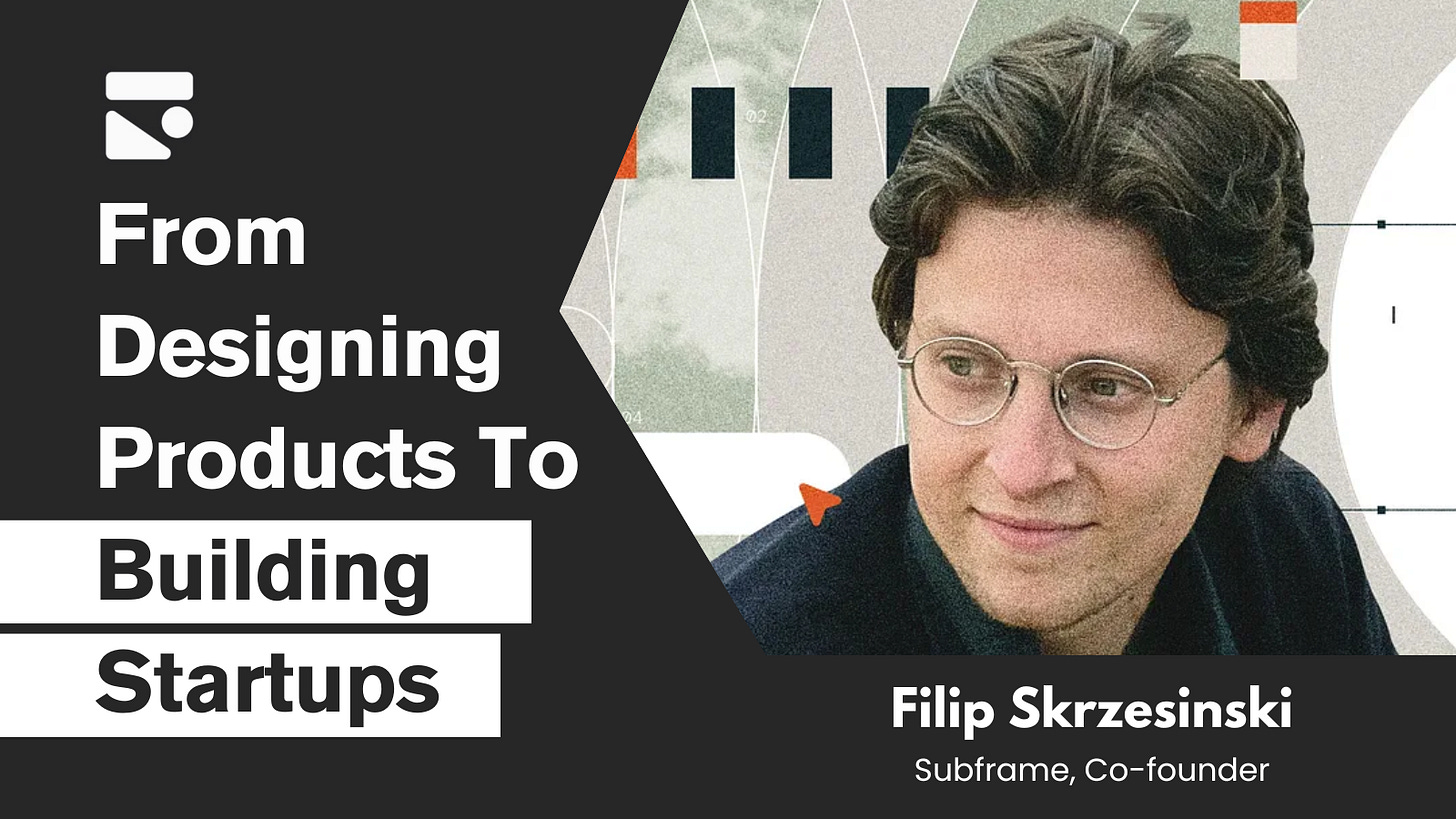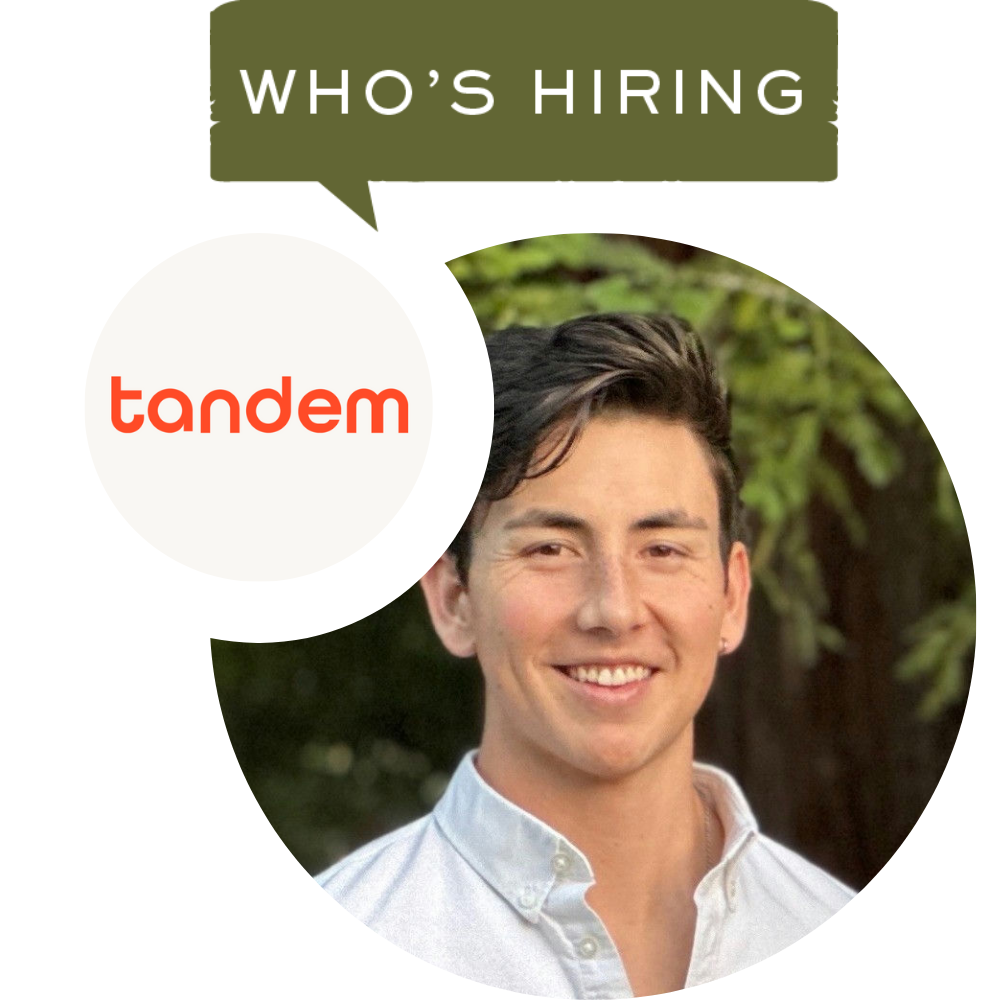🧑🎨🚀 Issue #137: Why Designers Should Start Building Companies
Filip Skrzesinski shares what it really means to design a company, how he balances intuition with speed at Subframe, and how AI has created a rare window for designers to excel at building companies.
💬 Welcome to issue #137 of StoryHouse Review
Good morning & happy Thursday. AI has fundamentally reshaped the landscape for designers who want to build products and companies. With today’s tools, designers can ship faster, work with smaller teams, and take ownership of the entire product experience in a way that wasn’t possible before.
This week, Claremont Colleges founder Filip Skrzesinski talks about what building looks like from the inside as an experienced designer who has worked at Smith.ai and Affinity. He shares hard-earned lessons on balancing speed with conviction, knowing when to ship and when to trust your intuition, and the shift from designing products to designing companies. It’s a Claremont Colleges world out there. 👇
~ Josh, Miles, Matthew, Pat
👤 Community Spotlight: Filip Skrzesinski & Subframe
Claremont Colleges entrepreneur Filip Skrzesinski (PO) is an experienced designer and co-founder of Subframe, a design-to-code platform that enables users to visually design user interfaces and allows teams to visually build their entire product UI in just minutes. Subframe is built around the idea of designing with code in mind, allowing for a seamless transition from design to production-ready code. Before founding Subframe, Filip worked in product design at Smith.ai, co-founded by fellow Claremont Colleges alum Justin Maxwell (PO ‘98), and in design systems at Affinity.
Filip was recently featured in an article by Design Founders, where he discussed the shift from designing products to designing companies, emphasizing that founder work is less about pixels and more about culture, decision-making, and long-term thinking. He also shares lessons from building Subframe, including how to balance speed with conviction, when to trust your gut, and why now is a rare moment for designers to start building their own companies.👇
Designer founders on pain-hunting, seeking competitive markets, and why now is the time to build
AI has fundamentally shifted the playing field for designers who want to build products. With the tools available today, you can ship faster and with smaller teams than ever before, no longer constrained by engineering bottlenecks or lengthy approval processes. The question isn’t just whether this changes everything for designers who want to start companies, it’s whether you'll move fast enough to take advantage of this historic moment.
Phil Vander Broek and Filip Skrzesinski offer two vantage points on this shift. Phil’s first startup, Dopt, was acquired last year by Airtable, where he now leads AI design. Filip is in the thick of building Subframe, a new UI design tool. One has the perspective of having been through the full cycle, while the other is building in real time.
What connects them is the conviction that good products come from understanding what’s actually worth building, and the shared belief that AI has created a brief window of opportunity for designers that won't last forever….
• Start a company in spite of your love of designing products
Filip Skrzesinski didn't leap into founding a company—it was “slow fermentation.” Years of working with systems: process-driven artwork, Markov chains before LLMs, visual languages built from component libraries and brand identities.
He left his job with no plan and no safety net, but realized he’d already been quietly working toward this moment for years. When he met his co-founders Irvin and Adam, it clicked immediately. Subframe started as a compulsion by people just crazy enough to build a better design tool from scratch.
But here’s Filip’s counterintuitive advice:
“Don’t start a company because you love designing products. Do it in spite of that.” - Filip Skrzesinski
“You won't be designing in the traditional sense—you’ll be designing the company’s DNA,” he explains. “It’s the invisible work: how you organize, how you think, how you make decisions. How it feels to work there, to use what you're making, to believe in it.”
The day-to-day reality becomes shipping quick fixes, sending outreach messages, releasing product emails, writing docs. All tasks eventually get delegated, automated, or made irrelevant. But the hard work is deeper. It’s cultural. It compounds.
“In the end, you’re signing up for something bigger than designing a product. Do it because you want to design things that outlive you.”
The takeaway: Before you start a company, ask yourself: Are you excited about designing products, or designing how a company thinks, decides, and feels? If it’s just the former, consider staying in a design role.
• Know when to go with your gut and when to just ship
Filip’s first job was working for Justin Maxwell, a designer-founder who became his mentor. “I saw the unglamorous side of early startups: you're in a windowless office, letting go of brilliant ideas that fizzle, and still showing up the next day to try again.”
But he also learned “the toolkit every designer-founder ends up reaching for: intuition, craftsmanship, and delusional confidence. You reach for these when you have no data, no traction, and no idea where you’re going—especially then.”
Above Justin’s desk was a quote from Charles Eames: “Innovate as a last resort.”
“Most of the time, this is the move,” Filip says. “Ship the defaults, optimize for speed. Intuition is a catalyst, but I like to say ‘I don’t know’ a lot. Shipping is knowing.”
But it’s a balancing act. At Subframe, some details matter deeply: “We're designing a tool people work in all day, so how drag and drop feels, how microinteractions enable flow states—that matters.”
Other times, you pursue ideas born from raw, long-term conviction, even when they look contrarian: “like rethinking how designs get handed off as code, or resisting chat-based AI to find more nuanced, contextual interactions.”
The key is knowing when to reach for the right tool. Where you choose to focus is also what you’re choosing to ignore.
The takeaway: Save invention for what truly needs it. Most of the time, shipping fast beats being clever. As Filip puts it: “What do I wish I’d known? When to reach for the right tool. And I’m still learning….”
Read the full article to learn why Filip believes now is a rare moment for designers to start building companies. 👇
🚨Claremonster Call-Out: VerifyYou & Primetime
Claremont Colleges alum Marty Weiner (HMC ‘03) was a founding engineer of Pinterest and Reddit’s first CTO. He is also the co-founder of StoryHouse portfolio company VerifyYou – a platform that leverages robust identity verification to reintroduce trust to online interactions. VerifyYou connects your government identity to a single, centralized account, allowing you to easily access all your social and payment accounts. Marty and his team have built a trust platform where users can complete all their identity verification and build their trust profile, then selectively share only the necessary data to verify aspects of themselves, such as age, proof of humanness, name, and ID verification.
If you're wrestling with PII headaches, want to inject more trust into your platform, or love talking trust tech, get connected with Marty. 👇
Claremont Colleges grad Zach Lupei (HMC ‘08) is the founder and CEO of Primetime, which enables CTOs to operate flatter and more communicative engineering organizations. Their agent embeds with the team, sitting on top of systems of record (Jira, Github, Docs) and communication channels (Slack, meetings). With that real-time knowledge base, Primetime’s agent works proactively to assign high-priority work, propagate status updates, and realign work based on management priorities. Team leads can offload project management work, eliminating hours of tedious tasks for your most valuable technical and product personnel.
Zach and his team are interested in speaking and connecting with Claremont College CTOs and engineering leaders who operate smaller developer teams and are interested in this space, or who have strong opinions on this topic. 👇
💼 Who’s Hiring?: Tandem, Kapta, & LMArena
Claremont Colleges alum Brendan Suh (CMC ‘19) and Rafi Sands are the co-founders of Tandem, a marketplace that helps companies share office space. Since launching in late 2023, Tandem has helped hundreds of companies find, lease, and share office space in SF and NYC. Their online marketplace uses AI to make the office leasing process less tedious. Earlier this year, the company announced its $6.1M Seed round led by Collide Capital and 1984 Ventures, with backing from StoryHouse Ventures, Y Combinator, and others. Tandem has seen double-digit month-over-month growth, and they are currently hiring for a Product Designer in SF.
Tandem also recently kicked off their new SF shared space for Y Combinator founders this summer. Get in touch with Rafi if you’re a part of YC S25.
UX Designer (On-site/SF) - ideally 3+ years of design experience working for smaller companies and a keen product sense
Milton Perque, former Chief Engineer of Echodyne, and Adam Bily are the co-founders of Kapta Space. Both were engineering leaders at radar platform company Echodyne, founded by serial Claremont Colleges entrepreneur Tom Driscoll (HMC ‘01). Kapta is adapting metasurface technology, currently used in electronically-steered antennas in the wireless communications industry, for space-based imaging and tracking applications. Earlier this year, Kapta emerged from stealth with a $5M seed round led by MetaVC, a Bill Gates-backed metamaterials venture fund, along with Entrada Ventures, Blue Collective, and StoryHouse Ventures. They are currently hiring for several open positions:
Claremont Colleges alum Cherry Park (SC) is the co-founder and Head of Marketing for LMArena, an open community platform for evaluating the best AI models. By comparing them side by side and casting votes for the better response, the community helps shape a public leaderboard, making AI progress more transparent and grounded in real-world usage. They recently announced their $100M seed round led by a16z and UC Investments, with participation from Lightspeed, Laude Ventures, Felicis, Kleiner Perkins, and The House Fund. Cherry is hiring for the following open roles:
Check out the other ~2,000 open jobs at 290+ Claremont-affiliated companies here on our Storyboard. Plus, create a profile and enter your preferences to get alerted to new job postings relevant to you, be they the ~300 remote jobs, 150+ internships, or 500+ part-time positions available. We’ve published research that shows that Claremont-founded companies that disproportionately hire Claremont talent outperform — so pay attention, Claremonsters!
If any of these roles catch your eye 👀 , apply and mention StoryHouse Review. Or, if you are an employer looking to hire tip-top Claremont talent, fill out this form to have your jobs featured.
🗣️ Conversations on the Interwebz:
This week’s must-watch 📺
StoryHouse portfolio company Speakeasy is a platform that provides developers with tools and workflows to create APIs optimized for both developers and LLMs. In this live session, Claremont Colleges grad Sagar Batchu (HMC ‘15), Speakeasy's co-founder and CEO, joined the Stripe Team to talk APIs, Agents, and MCP servers. They conducted a live demo, transforming Stripe's multi-megabyte API spec into a full MCP server in real-time with Gram—Speakeasy’s new platform for creating, curating, and hosting agentic tools.
This week’s Claremont financing 💸
Congratulations to Claremont Colleges alum Shreyas Kumar (HMC ‘14) and FERMAT on their recent $45M Series B led by VMG Partners, with continued support from QED Investors, Greylock, Bain Capital Ventures, and Courtside Ventures. As co-founder and CTO, Shreyas is helping transform e-commerce through FERMAT’s proprietary commerce graph and AI-driven platform, enabling fully personalized shopping experiences and more effective advertising for both human and agentic consumers.
Conveyor automates and scales the most tedious parts of the sales process. Their AI Agents fully automate tedious tasks, from Trust Center automations to generating instant answers for security questionnaires and RFx's. The company recently secured a $20M Series B led by SignalFire with participation from Oregon Venture Fund and Cervin Ventures. Claremont Colleges grad Chris Gomes (PO ‘09) is a founding team member and Conveyor’s current Head of Product.
Claremont Colleges alum Gator Halpern (PO ‘12) is the co-founder of Coral Vita, an environmental restoration company focused on revitalizing dying and damaged coral reefs by growing corals in controlled, land-based facilities. Coral Vita recently raised $8M in Series A funding led by Builders Vision to accelerate its mission to restore degraded reefs, deploy ecological infrastructure, and help preserve the ocean's biodiversity and prosperity!
Everything else you need to know💡
Serial Claremont Colleges entrepreneur Jennifer Good (CMC ‘13) is the founder and CEO of Peacefully, an all-in-one platform designed to support families with the complex, time-consuming tasks that follow the death of a loved one. In a major milestone, Peacefully was recently acquired by Homethrive, a leading comprehensive caregiver support platform.
Can’t get enough of StoryHouse Review? Follow and connect with us on Twitter!
🍽️ BTL Snacks:
🧠 Smarter AI for Patent Professionals….. Claremont Colleges alum Alexander Flake (HMC ‘14) is the co-founder and CEO of Patentext, an AI-powered patent drafting tool designed to streamline the process of creating and reviewing patent applications. He explains why most AI tools miss the mark for solo patent agents and what to look for instead. Drawing from his freelance experience, he shares frustrations with clunky output and overpriced tools built for teams. Alex also makes the case for AI that works out of the box, mirrors real patent workflows, and helps solo practitioners move faster without cutting corners.
💡 How Hamlet Makes Public Data Useful….. Serial Claremont Colleges entrepreneur Sunil Rajaraman (CMC ‘01) is the founder of Hamlet, a venture-backed startup that transforms complex information from local government into accessible insights for real estate developers, land use attorneys, and government relations execs. Sunil shares how a confusing city council meeting sparked the initial idea for Hamlet, and how AI can turn public hearings into usable information. The article also highlights Hamlet’s use by real estate developers, its value for journalists and housing advocates, and its mission to move civic data from transparency to true legibility.
Feedback? We love to hear it. Hit us with an email. 👊🏼
















